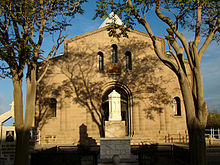|
Shoghakat Church of Tabriz
The Shoghakat Church or Shoghagat Church (Armenian: Թաւրիզի Սուրբ Շողակաթ եկեղեցի, Շողակաթ եկեղեցի, T’avrizhi Surb Shoghakat yekeghets’i, Persian: کلیسای شوغاگات مقدس) is an Armenian Apostolic church in Tabriz, East Azerbaijan province, Iran completed in 1940. LocationSaint Shoghakat Church is located at the Armenian cemetery of Tabriz, which is surrounded by Charm Street, Mashruteh-Boulevard and Bolvar-e-Mollasadra, at Charm Street opposite to the Faculty of Architecture of Tabriz Islamic Arts University, the former Khosravi Leather Factory, not far from the southern end of South Shariati (South Shahnaz). HistoryIn old times, the Armenian Christians of Tabriz used to bury their deceased at the cemetery near Mariam-Nanna Church in Maralan. In the 1850s, the land of the new Armenian cemetery of Tabriz was purchased by the Diocese of Tabriz when Sahak Satunyan was bishop. However, the church was built only in the 20th century. Construction of Saint Shoghakat Church was financed by Simon Manocherian, a leather-manufacturing director whose mother's name was Shoghakat, and completed in 1940.[1] The name of the church refers to a ray of light (Շողակաթ) that came down from heaven upon 38 Armenian nuns martyred by the pagan Armenian King Trdat around AD 301 at the site of the famous original Shoghakat Church of Etchmiadzin in Armenia built in the 6th century. Seeing Heaven's Light, Trdat converted to Christendom, and Armenia became the first Christian country. ArchitectureThe shape of the church is rectangular with four square columns located in the middle carrying the dome, dividing the interior into two naves on both sides and a wider main nave in the middle. The entrance to the building is on the western side facing the sanctuary in the east. The exterior stone facades of the church are framed with semicircular and oval arches on north, south and west side.[1]   Notable burials
See also
External links
References
|
||||||||||||||||||||||||||
Portal di Ensiklopedia Dunia



